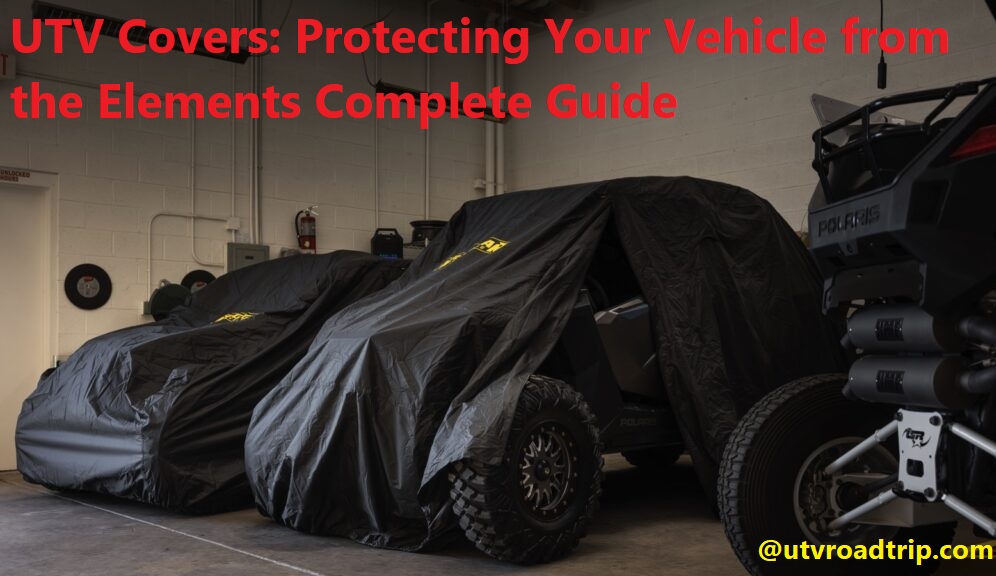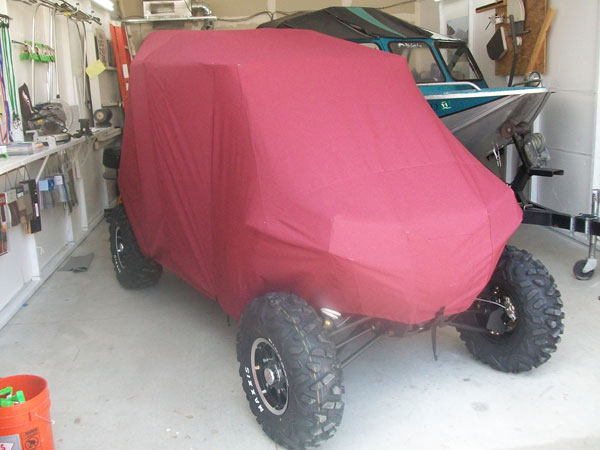Do you want to protect your vehicle from harsh weather elements?
This guide provides all the information you need to make sure your vehicle stays safe, secure and in prime condition year-round. Discover how UTV covers can be used to increase longevity and keep you driving in comfort.
UTV covers are an essential part of protecting your vehicle from the elements. In this guide, we will discuss what UTV covers are, when they should be used, and the benefits they offer. We will also cover a range of UTV cover types, so you can get an idea of the best options available to you.
UTV covers come in a wide variety of styles and materials to accommodate different needs. Whether you’re looking for something lightweight and easily foldable or something heavier-duty to prevent water damage and corrosion, there is sure to be an option that meets your vehicle’s needs. We’ll go through different types of UTV covers – from all-weather fabric covers with waterproof membrane liners to universal fit heavy-duty vinyl models – so that you can decide on the best option for your UTV.
Finally, we’ll discuss some things to consider when selecting a cover, such as size and color choices as well as pricing guides and warranties associated with the products so that you can confidently choose what’s right for both your vehicle and budget.
Types of UTV Covers
It’s important to choose the right cover for your UTV, because not all covers will provide the same level of protection. They come in different sizes and styles to accommodate different types of use. Here is a breakdown of the four main types of UTV covers:
Soft UTV Covers: These are padded covers made from waterproof material like neoprene, canvas, or polyester. They are lightweight and easy to put on and take off your UTV. They provide good protection from dirt, dust, and debris but do not offer any weather protection like other covers.
All-Weather UTV Covers: These covers are designed to withstand any type of weather conditions including rain, snow, sleet, wind etc. It is usually made of a sturdy material like nylon which is both water and tear resistant. This type of cover offers optimal protection from both the elements as well as UV rays which can cause fading or sun damage over time.
Heavy-Duty UTV Covers: Heavy-duty covers are great for those who leave their vehicle outside for long periods of time and need superior protection from all kinds of weather conditions as well as impacts caused by animals or branches that can harm it. They are usually made with materials such as heavy duty vinyl or canvas which offer extra security against bad weather elements like snowfall or strong winds.
Customized Covers: Customized UTV covers have multiple layers that offer superior protection against all types of damage and wear & tear. The size is tailored to fit each specific make and model perfectly so it fits snugly around the vehicle providing maximum coverage that won’t scratch its surface or interfere with any part on it while still giving enough room for you to access any part easily without having to remove the entire cover each time you want access inside your car.

Discuss the different types of UTV covers available
When it comes to protecting your UTV from the elements, there are a variety of UTV covers available to suit different needs. Types of covers include heavy-duty, medium-weight, lightweight, and silicone-coated. In addition to these types of covers, there are also various sizes and colors of covers.
Heavy-duty UTV covers provide greater protection than other types as they can provide some protection against UV rays and light rain or water splashes. These highly durable covers are ideal in extreme weather conditions and also help protect against dust, dirt, and other airborne particles that can damage the surface of your UTV.
Medium-weight UTV covers provide the same amount of protection as a heavy-duty cover but with a lighter weight material that is easier to handle when putting on or taking off the cover. They typically come in an array of colors and waterproof materials that can help repel moisture and keep your ride looking great for longer periods between washes.
Lightweight UTV covers offer just enough protection from environmental elements such as wind, dust, light rain & sun damage while still being lightweight enough for easy handling & storage when not in use. Made from lighter fabrics than medium & heavy duty styles, yet still offer tire coverage for reducing wind drag on open roads.
Silicone coated UTV covers are made with a layer of silicone coating, which helps protect your vehicle’s surface against the sun’s rays by reflecting away some heat energy from direct sunlight exposure and delaying the onset of oxidation through a protective barrier layer on top. This type of cover is more breathable than heavier materials allowing better air flow over its entire surface while still keeping dust covering away from surfaces it would otherwise build up on without use low breathability materials like plastic sheeting or ultra thin fabrics that hold little air flow when not in use compared to silicone-coated fabrics usually seen with weighty materials like wetsuit fabric neoprene that can be found with impact resistant design features like bolster sew techniques and double layered seaming construction methods that make sure all sides seams agree well formulated pressure points considered carefully before production thus maintaining reliable strength long time performance after long time usage without fail depending solely upon manufacturing details & quality assurance practices towards overall production cost effectiveness percentage every retailers should consider!
Compare and contrast each type, including their advantages and disadvantages
When it comes to UTV covers, you’ll find several types, each offering different advantages and disadvantages. It’s important to understand the trade-offs when deciding which type is best for your particular needs.
Cotton Covers: Cotton covers are lightweight and easy to install, making them ideal if you want something quick and simple. However, they offer minimal weather protection and don’t last long against sun damage or high winds.
Vinyl Covers: Vinyl covers are typically thicker than cotton but still quite lightweight. They offer better weather protection than cotton but again don’t provide the same level of durability in strong winds or rain.
Heavy-duty Covers: Heavy-duty or waterproof UTV covers are thicker and sturdier than cotton or vinyl options. These heavier materials provide better protection from the elements but also require more effort when installing and removing them from your vehicle.
All-weather/Four Season Covers: All-weather/four season covers provide the most comprehensive protection of all types of UTV covers by combining a combination of water resistance, UV ray protection, wind resistance, heat retention, etc. The downside is that these cover tend to be most costly of all cover types as well as require more care when storing them due to their weight and bulkiness.
Provide examples of each type
Having the right cover for your UTV can help protect it from dust and moisture, as well as help keep it looking good. The two basic types of covers are waterproof and non-waterproof. Depending on the model you have, and how much use you plan to get out of it, each type may offer different benefits.
Waterproof Covers: These provide maximum protection against moisture and dirt accumulation, making them ideal for storing your UTV inside a garage or carport. They’re also more durable and can withstand some UV light deterioration.
Examples of waterproof covers include: – Polyester fabric; this is usually the least expensive option and offers good protection against dust but may not be ideal if you need to travel with your UTV in wet conditions; – Vinyl-coated polyester fabric; this is a middle-of-the road option that offers better water resistance than basic polyester but isn’t as strong or long lasting as other materials; – Marine grade polyester fabric; this is designed for maximum water protection with high levels of UV resistance, great breathability, and some windproofing features. It’s usually sold at higher prices but will last longer than basic polyester covers; – PU Coating (Polyurethane); This is often considered the best material available due its waterproof properties, high tear resistance, and excellent UV resistance – all at an affordable price point. It can be used indoors or outdoors with equal effectiveness.
Non Waterproof Covers: These are generally made from lightweight fabrics such as cotton/nylon blends or lycra/spandex mix fabrics which offer some light dust protection but won’t stand up against moisture or strong winds very well. They’re typically recommended for indoor storage only or when using a stable overhang such as a porch cover for short periods of time.
Examples of non waterproof covers include: – Nylon mesh with mesh covers; this type of cover offers decent ventilation while blocking out most dust particles, providing an effective solution when storing your vehicle indoors; – Knit Fabrics (typically cotton); these are lightweight materials that provide limited protection from dust particles while offering decent breathability at an affordable price point; – Microfiber/Lycra blend fabrics; these are lightweight materials designed to fit snugly around various shapes and sizes providing a moderate level of breathability along with being sweat resistant;
Ultimately which cover works best depends on how you plan on using your UTV – whether it will be stored in a garage or outdoors in extreme weather conditions — so make sure to keep that in mind when making your selection!
Factors to Consider When Choosing a UTV Cover
There are a few key factors to consider when selecting a UTV cover for your vehicle. The size of the cover is one of the most important considerations; it must be able to fit comfortably and securely over the entire body of your UTV. It should not be so loose as to flutter in the wind, but it should also not be so tight that it restricts movement. Additionally, consider where you typically store your UTV. If you garage it, you may want to invest in a heavy-duty breathable UTV cover, while those who store their vehicle outdoors could benefit more from a thicker waterproof fabric.
When choosing materials, there are advantages and disadvantages to both vinyl and polyester covers. Vinyl is lightweight and flexible, malleable enough to conform snugly around the curves and contours of your ATV’s body for maximum protection. On the other hand, polyester is heavier than vinyl but has increased durability and longevity regardless of weather conditions.
UV resistance is also an important factor; many covers offer built-in UV-protection that shield against damaging ultraviolet rays, preventing sun damage or fading over time. Additionally, air vents may help allow air circulation beneath the cover while remaining waterproof on top; this can protect against mildew build-up while not compromising coverage or protection from rain or snow.
Finally, look for covers with grommets at both the front and rear that allow straps or ropes to secure them firmly in place in even high winds or significant weather conditions.
Explain the important factors to consider when choosing a UTV cover, such as size, material, and durability
When choosing a cover for your UTV, it’s important to consider various factors such as size, material, and durability. Finding the right fit is key as an ill-fitting cover can lead to air pockets and additional wear and tear. Some covers come with an elastic hem or draw string, making them easier to cinch down in order to better fit the contours of your machine.
Material should also be taken into consideration when selecting a UTV cover. Generally speaking, the lighter weight fabrics are ideal for warmer climates while heavier fabric options are best suited for cold weather climes where changing conditions can cause the material to freeze. In coastal areas you’ll want to choose a waterproof fabric like nylon or canvas; however, these materials won’t breathe so you may want to go with something more breathable if you don’t plan on using it in extreme conditions.
Durability is another important factor that should be taken into consideration when selecting a UTV cover. Look for sturdy materials that will hold up against wear, abrasion and exposure over time without deteriorating quickly or losing its color or integrity due to sun damage or other elements of wear and tear associated with outdoor use.
Aside from providing your vehicle protection from the elements and dust gathering indoors, UTV covers also add an extra layer of security against theft or vandalism when parked outside in public spaces or overnight at campgrounds during adventure trips.

Discuss how each factor can impact the effectiveness of the cover
Choosing a UTV cover for your vehicle involves several factors – material, size, fit, waterproofing and breathability. Each of these aspects plays an important role in protecting your vehicle from the elements and ultimately determining the effectiveness of the cover.
Material: When considering a UTV cover, it is important to pay close attention to its material. Covers can be made with woven polyester or vinyl that is made to withstand harsh weather and other outdoor elements. If you go with a vinyl cover, it must be waterproof – not all polyester covers are water-resistant! The weight of the material will influence how easily it can be put on and removed from your vehicle. Finally, consider the type of finish applied to what you’re purchasing; matte finishes often reflect less UV light than a glossy finish, which may help reduce fading over time.
Size & Fit: An ill-fitting cover can provide less protection by letting in moisture and debris that can potentially harm your vehicle. Depending on make and model year, some UTVs may have different features such as roll cages or aftermarket accessories that will require specific sizes for adequate coverage or adjustable elastic sides for an extra snug fit. Additionally, double-check if any special sizing options are available based on attachments like windshields and cab enclosures before selecting the right size for your UTV.
Waterproofing: Many covers provide sufficient waterproofing by itself but there are also products designed with additional waterproof additives to help keep water out in more severe conditions like heavy rain storms. It’s best practice to review features like taped seams or weatherproof flaps designed specifically to keep moisture out of sensitive areas such as doors and windowsills so your machine isn’t left vulnerable when exposed to those kinds of conditions outdoors.
Breathability: Allows moisture trapped under the fabric capture moisture generated beneath the surface due condensation build up from contact between hot surfaces and cool air temperatures outside during temperature swings between day and night cycles– especially relevant when keeping equipment covered indoors during long stretches without use. In order for this process occur effectively with minimal damage potential to interior components—look into technicalities like number vents added breathability capability vs solid backings although better resembles high quality truck bed liners without sacrificing any protection qualities needed retain longevity outdoors along all climates— A great mix helps balance performance protection outdoors rounds off set pieces automated setup take full advantage needed features put together laid our procedures step by step directions concisely clear concisely clear executable deliverances—
Maintenance and Care for UTV Covers
Keeping a UTV cover in good condition for optimal protection will require regular maintenance and care. Maintaining the cover can help to preserve the fabric, preventing it from wear, fading, mold or mildew buildup that is caused by the outdoor elements. Here are some tips to consider when caring for your UTV cover:
-Periodically check your UTV cover and make sure that it still fits snugly on your vehicle, as over time stitches and material can become loose or torn.
-When you’re storing it away, either in your garage, shed or somewhere else, use a bag or box so dirt and debris don’t accumulate on the fabric.
-Try to keep the cover away from direct sunlight as much as possible to prevent color fading due to UV rays.
-Using a damp cloth (not soaking wet) periodically remove dirt particles from your UTV cover. If necessary, use a mild detergent solution.
-Always read and follow any specific washing or cleaning instructions provided by the manufacturer of your UTV cover before using any detergents on it.
-Let it air dry naturally before using again if you do get it wet during cleaning and maintain manufacturer’s instructions regarding storage after every use.
Discuss how to properly care for and maintain a UTV cover
Caring for and maintaining your UTV cover is an important part of its lifespan. Proper cleaning and storage will help to extend the life of your cover and protect your vehicle from the elements.
Before storing your UTV cover, it’s important to make sure it is cleaned thoroughly. Remove any dirt, debris and vegetation from the surface with a soft brush or by lightly scraping them off with a plastic razor blade for the best results. Be careful not to damage the fabric when cleaning around straps, buckles or other hardware on the cover.
If you notice stains on your UTV cover, be sure to spot clean them with warm water and a mild detergent as soon as possible. Once you have removed any dirt or debris, wipe off any excess moisture using a damp cloth. Allow the fabric to air dry completely before storing it away in a cool, dry place out of direct sunlight.
To prevent mold and mildew growth, treat your UTV cover with an approved fabric protectant solution on both sides prior to storage each time you use it. It’s also important to inspect straps, buckles and other hardware regularly for signs of wear that may need to be replaced before using the cover again. Finally, rather than folding or crumpling up your UTV cover when storing it away in between uses; roll it up loosely which will help reduce wrinkles that can lead to tears in the fabric over time.
Explain the steps to take to keep a cover clean and in good condition
Keeping your UTV cover clean and in good condition requires some basic steps that should be done regularly.
Firstly, remove any dirt and debris from the cover before you put it on or store it away. You can do this using a soft-bristled brush or cloth, such as microfiber or chamois. Additionally, it is recommended to use a mild soap and water solution to ensure that all dirt and debris are removed from the cover’s surface.
After cleaning the cover of dirt and debris, inspect the entire material for any signs of wear or tear. Should you find any weak spots in the fabric of your UTV cover, consider replacing it immediately to prevent further damage down the line.
Finally, make sure that you store your UTV cover appropriately when not in use. This can include keeping it in a mesh storage bag as well as putting it in either a dry, cool space inside your house or garage (if possible). Additionally, if you reside in a very humid climate where mold is common we recommend rolling up both sides of your UTV cover while not being used to provide more airflow throughout the material and reduce moisture buildup from occurring over time.
Conclusion
The main takeaway from this article on UTV covers is that protecting your vehicle from the elements can be a huge advantage. It can add life to your vehicle and prevent unexpected damage due to extreme weather conditions. In addition, it can improve the style and color of your vehicle in just a few minutes!
For UTV owners, investing in quality covers is a must. There are many different materials and styles available, so finding one that meets your needs should not be a problem. Finally, follow care instructions to make sure that you extend the life of your UTV cover as long as possible.

FAQ’S
What are the benefits of a car cover?
Car covers can protect your car from damage caused by harsh weather conditions, dust, dirt, bird droppings, and other debris. They can also help prevent theft and deter vandalism.
How do you secure a car cover?
Car covers usually come with straps, clips, or tie-downs that can be used to secure them to the car. You can also use a cable lock or bungee cords to further secure the cover.
Are car covers good for your car?
Yes, car covers can be good for your car as they offer protection from external elements that can cause damage to the car’s exterior and interior.
What are the disadvantages of a car cover?
Some of the disadvantages of using a car cover include the possibility of scratches on the car’s surface, damage to the cover from environmental elements, and the inconvenience of putting on and taking off the cover.
Do car covers protect from damage?
Yes, car covers can protect your car from damage caused by external elements such as UV rays, rain, snow, hail, and wind.
When should you put a cover on your car?
You should put a cover on your car when it is parked outdoors for an extended period, during harsh weather conditions, or when you are going away on vacation and leaving your car behind.
How important is engine protection cover?
Engine protection covers are important as they can protect the engine from debris, water, and other environmental factors that can cause damage or corrosion.
Do car covers protect the engine?
Car covers can offer some protection to the engine from environmental factors such as dust, debris, and water, but it is recommended to use an engine protection cover specifically designed for this purpose.
Which type of cover is best for car?
The best type of cover for your car will depend on the climate and weather conditions in your area, as well as the level of protection you require. Some popular options include waterproof covers, UV-resistant covers, and breathable covers.
How do you properly use a car cover?
To properly use a car cover, make sure it fits snugly over the car, with no gaps or loose areas. Secure the cover with any straps or clips provided, and make sure it is properly anchored to prevent it from being blown away in strong winds. When removing the cover, be careful not to drag it across the car’s surface to avoid causing scratches.
See Also :


